How to grow walnuts from walnuts at home?

Walnut is a popular fruit crop that can be grown at home. This tree will live for many years if properly planted and cared for. In today's article, we will find out how you can grow walnuts from walnuts yourself at home.
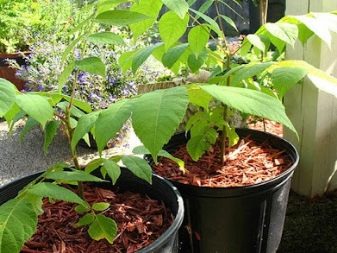
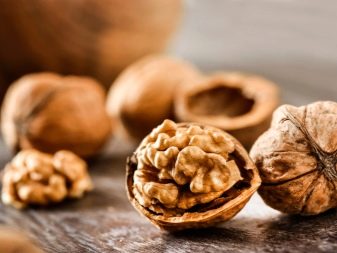
Seed selection
The first step is to choose the right seed material for the further cultivation of walnuts. This stage is one of the most important, therefore, it is advisable for a person to show maximum care, to treat the process responsibly.
To successfully germinate a fruit tree at home, you need to pay attention to a number of basic parameters of the seed.
- It is very important to pay attention to the variety that owns the material for further sowing.... If the nut will be grown as a regular houseplant, then almost any existing varieties can be turned. If in the future the culture is moved to open ground conditions, then it is better to give preference to varieties of zoned types. We are talking about such varieties of walnuts that will feel comfortable in specific climatic conditions.
- An important role is played by the mass of the nut, which will then be used for germinating a fruit tree at home. The nut must be heavy enough. If it is too light, then this will indicate that its nucleolus is either dry or rotted. The latter options are not suitable for disembarkation.
- It is worth taking a closer look at the thickness of the nut shell. The easiest way is to germinate those fruits that have a thinner shell.
- The gardener will need to carefully consider the seed material, assess the state of its appearance. For planting, it is allowed to use those fruits that have a whole and intact shell. Those specimens that are covered with unnecessary holes or mold stains, and also have rotten areas, are completely unsuitable for further use.


For planting, you can use those nut fruits, the age of which is no more than 1 year. The older the planting material is, the weaker its germination is.
Dried materials, as well as fruits that have previously been processed at elevated temperatures, are not suitable for growing walnuts. The nucleoli in such nuts are already inanimate, therefore, it will not work to observe how they germinate.
If purchased nuts are used, then they are pre-dried. In order for the shell to acquire lighter shades, such components are soaked in a chlorine-based solution. For this reason, it is recommended to give preference to those fruits, which were self-assembled and not found on store shelves.


How to germinate a nut fruit?
When ideally suitable nut fruits are found, you can proceed to the procedure for their further germination. It is necessary to properly germinate a walnut in accordance with a number of basic rules. If done correctly, you can achieve good results.
Drying
It should be borne in mind that the best time for picking nut fruits is autumn. September or October is optimal.The harvested whole fruits are subjected to a drying procedure. Only after this stage can one proceed to the next important process - stratification. It should be borne in mind that only peeled whole walnuts are dried. The procedure can be carried out under the influence of the sun, after which the materials are laid in the shade.
It is not allowed to use heating equipment in order to quickly dry the nuts.


Stratification
Consistency is very important when growing a walnut tree. After drying, you can safely proceed to the procedure for stratification of the seed. This concept means the correct storage of nuts. They must be peeled and dried. They need to be stored dry for 18 weeks. In this case, the temperature should be maintained at + 2-3 degrees Celsius.
It is possible to plant the nut fruit in the fall, but if this was not done, then the sowing materials will need to be stored until the spring season. In this case, the seed will need to be kept in moist sand. It is advisable to place the nuts in the basement, where the temperature indicators drop to a level not lower than 0 degrees Celsius. A fruit that has undergone such training can be planted towards the end of March or in April.
If the nut shell is too dense, the stratification procedure will include the following nuances.
- It is necessary to prepare a suitable container, on the bottom of which you will need to pour moistened sand. It should be borne in mind that humidity should be moderate, not excessive.
- The harvested walnuts must be laid out on the edge. This should be done so that the gap between the shells is both above and below.
- If all fruits are placed in a single container, then it is important to leave a distance of at least 2-3 cm between them.
- It is allowed to pour one more layer of soil on top, and then place another batch of seeds. This batch can also be covered with sand on top.
- If storage space permits, each nut can be planted in a separate container.
- Further, seedlings with thick shells are removed to a room where the temperature is kept from 0 to 15 degrees Celsius. The seed must remain here for at least 100 days. It is important to monitor the moderation of soil moisture. If drying takes place, then light irrigation will be needed.

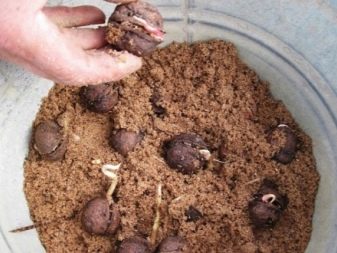
Sowing
Sowing must be done according to several important rules. Let's figure out each of them.
- Nuts should be placed in a suitable soil mixture in late autumn and preferably sideways. And it doesn't matter at all whether they are showing sprouts that have already hatched, or they are just being planned.
- If the material is laid on its side, it will be much easier for the plant to exit through the shell. Due to this, the beginning of development will be simple and quick.
It is necessary to be very responsible about the selection of the container in which the walnut tree will grow.
- For planting, a deep pot is best suited, in which a drainage layer is provided. The optimal diameter of the first container will be 30 cm. Due to such dimensions, the nut rhizome will be able to sit freely and comfortably.
- Each time you transplant, you will need to prepare new pots. Each time, the diameter of the container should gradually increase by 8 cm compared to the previous container.
If you choose the right container in order to plant a nut, then the plant will feel as comfortable as possible. This will have a beneficial effect on its condition, growth rate and fruiting in the future.
If it is planned to grow walnuts in a region where there is a rather warm climate, then you can immediately plant prepared and high-quality seed in open ground.
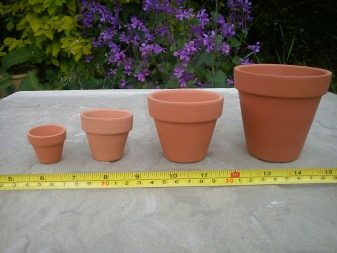

How to care for a seedling?
Walnut seedlings will need proper and regular grooming operations. Consider how to care for the plant.
- It should be borne in mind that the walnut is a light-loving crop. Even at the stage of development of the seedling, it will need a lot of sunlight. It is advisable to place plantings on a windowsill on the west or south side. If this is not possible, then you can turn to the use of fluorescent lamps.
- Temperature regimes under which seedlings develop also play a very important role. Walnut feels great against the background of room temperature. If the weather is warm outside the window, then the room in which the landings are located must be ventilated.
- Seedlings and hardening will be required. The walnut tree begins to be taken out of the dwelling when the air temperature reaches +15 degrees Celsius. At night, the culture is brought back into the room. In summer, when the nights are just as warm, walnuts can be left outside overnight. With such procedures, the plant can easily transfer the transplant to open ground in the future. Even those specimens that will remain in the room should still sometimes be taken out into the street for hardening.
- Nut sprouts will need to be watered as the soil mixture dries... The liquid is applied under the roots. It is important to ensure that the soil does not dry out too much, but there is no high humidity either.
- In order for the walnut tree to form a sufficiently strong root system, which will easily adapt to other conditions after transplanting, its base must be mulched with peat.
- Once every 2 weeks, the culture must be fed with complex fertilizers.that contain potassium. For sprouts, use half the normal concentration.
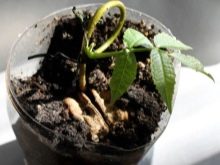
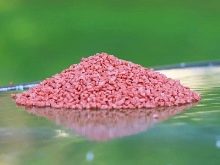

Transplant to open ground
If the seedlings were provided with competent care, then at a certain point they will be completely ready for transplantation into open ground and a summer residence. Usually, such operations are started about a year after the first sowing measures. By this time, the culture manages to get stronger enough to adapt to completely new conditions for it.
All basic planting procedures are usually carried out in the spring season, when the temperature outside is +15 degrees Celsius.
- It is very important to find the optimal place for transplanting a developed seedling. It should be borne in mind that the culture in question can grow very abundantly, releasing a voluminous crown. That is why the trees are placed at a distance of 6-8 m from nearby buildings, as well as 3 m from other trees on the site.
- Groundwater should not pass closer than 1.5-2 m. This is due to the too strong core roots of the walnut. A neutral type of soil or a slightly acidic version is ideal.
- It is advisable to prepare the selected transplanting site already from the autumn season.... The area allocated for the nuts is dug up, and also carefully cleared of any weeds. In this case, the soil must be combined with fertilizing components. For this purpose, about 6 kg of humus, 35 g of superphosphate, 30 g of potassium fertilizer, 30 g of ammonium nitrate should be scattered on each square meter. After that, the soil layer will need to be dug again.
- With the arrival of springtime, the soil must be cleared of new weeds that have appeared. Leveling with a rake will also be required. You will need to dig a hole at least 60 cm deep and 40 cm wide. You will need to pour a heated solution of copper sulfate into it. The soil mixture removed from the hole will need to be mixed with a bucket of humus and 1 kg of ash.
- At the bottom of the hole made, 10 cm of the drainage layer should be poured, and on top of it - 5-10 cm of the nutrient soil mixture. After that, the walnut removed from the pot, along with a lump of earth, is placed in the hole. The remaining volume will need to be filled with soil.
- Further, the culture will require mandatory watering. The lack of soil needs to be replenished. In this case, the ground should not cover the root collar.
It is advisable to mulch the trunk circle.
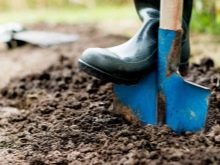

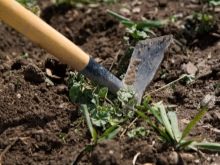
Further care
Transplanting walnuts from home to outside is very easy, but this is not enough for good tree growth. The culture will definitely need proper care. Let us consider in detail how it will be necessary to properly water, feed and cut walnuts grown from walnuts.
- Watering... It is very important to consider the fact that young plants need more care than mature specimens. The plant will need proper watering. This procedure will need to be resorted to every 2 weeks. For 1 square meter, 4 buckets of water are taken for this. The temperature of the latter should be room temperature. The ground layer, which is surrounded by walnuts, should not dry out. It is very important for the gardener to keep the planting condition under control. Moisture stagnation must not be allowed. If you water the nut more often than once every 14 days, then it will be much harder to survive the cold that will come with the winter season.
- Top dressing... The tree will bear fruit well if you provide it with proper and appropriate nutrition in the form of high-quality dressings. If a sufficient amount of fertilizers was applied at the stage of planting the crop, then during the first 3 years they will no longer be useful to the nut. Then, every spring, the nut will need nitrogen fertilizers, and in the autumn season - phosphorus and potash. Thanks to such components, the tree grows faster, gives more high-quality full-fledged fruits.
- Pruning... Walnut cultivation involves pruning. As a rule, they begin to do this from the second year after planting a crop on a personal plot.
In the course of pruning, a neat and beautiful crown is formed. At the same time, all weakened, damaged and dried branches are removed. The procedure is carried out annually.

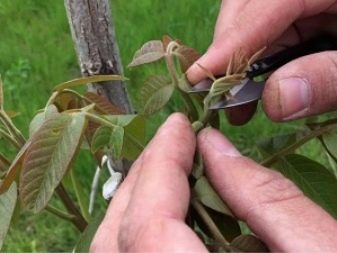









The comment was sent successfully.